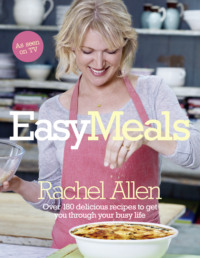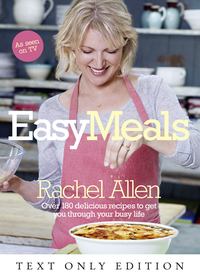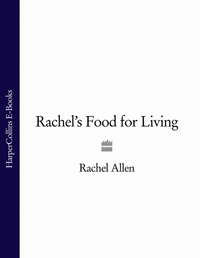
Полная версия
Entertaining at Home
To serve
Handful of roasted, peeled (see Rachel’s tip below) and roughly chopped hazelnuts
2–3 tbsp chopped parsley
1 Melt the butter in a large saucepan on a low–medium heat, add the chopped onion, potato and celeriac and season with salt and pepper. Place a butter wrapper or piece of greaseproof paper on top, cover with a lid, reduce the heat to low and cook for 7–8 minutes, stirring regularly.
2 Pour in the stock, bring to the boil, then reduce the heat and simmer for a further 10 minutes or until the vegetables are completely soft. Add the cream and the chopped herbs and blend the soup in a blender or using a hand-held blender until it is smooth and velvety. Taste for seasoning.
3 To serve, ladle into warmed bowls and sprinkle with the roasted hazelnuts and parsley.
RACHEL’S TIP
To roast and peel hazelnuts, preheat the oven to 200°C (400°F), Gas mark 6. Place the hazelnuts on a baking tray and cook for about 10 minutes or until their skins have darkened, then remove from the oven. To remove the skins, wrap the nuts in a clean tea towel while they are still warm (I find this tends to slightly stain the tea towel, so don’t use your favourite!) and rub together. The skins should come off easily.
Tuscan beans on toast
This is the best ever beans on toast that you can imagine. But there’s no tomato sauce here, just lots of delicious sweet pungent garlic, fresh lemon juice and lashings of chopped parsley. Serve on your favourite kind of toast.
SERVES 6 VEGETARIAN
400g (14oz) dried haricot or cannellini beans
1 bay leaf
8 large cloves of garlic, peeled
6 slices of bread
Butter, for spreading
6 tbsp chopped parsley
2 tbsp lemon juice
4 tbsp olive oil, plus extra for drizzling
Salt and ground black pepper
Lemon wedges, to serve
1 Soak the beans overnight in enough cold water to cover by several centimetres. Drain the beans and place in a large saucepan filled with fresh cold water. Add the bay leaf and garlic and bring to the boil. Reduce the heat, cover with a lid and simmer for 1–2 hours or until very soft, skimming off any foam that rises to the surface.
2 Just as the beans have finished cooking, toast the bread, spread with butter and place on individual plates.
3 Meanwhile, drain most of the liquid from the beans, leaving a few tablespoons with the beans in the pan. Take out one-third of the beans and the garlic and mash together to form a rough paste.
4 Discard the bay leaf and stir the paste into the cooked beans, along with the parsley, lemon juice and olive oil. Season with salt and pepper and serve on the slices of hot buttered toast with some extra oil drizzled over and lemon wedges.
RACHEL’S TIP
If you are being spontaneous and want to make this immediately, instead of the dried beans you could use 3 × 400g tins of cooked haricot or cannellini beans. Drain and rinse the beans, then place in the saucepan with the bay leaf and garlic, peeled and crushed, and simmer on a low-medium heat for about 5–10 minutes (or until the beans are soft enough to mash), then proceed as above.
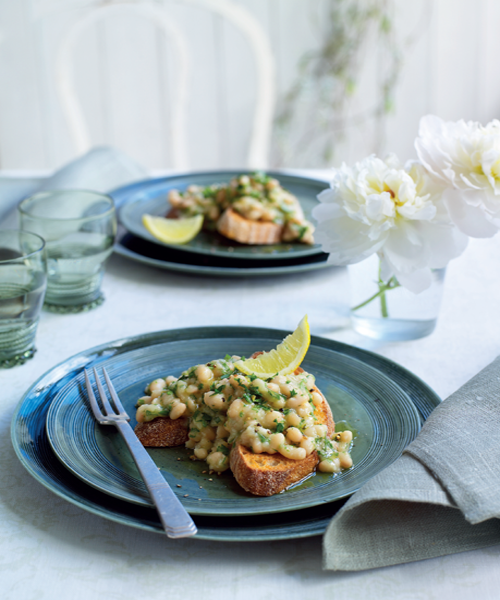
Creamy fish pie with mushrooms, cucumber and leeks
This fish pie is so easy to make. You don’t need to mash the potatoes and pipe them over the top as they are layered into the pie. Leeks and mushrooms are a classic combination, but the fairly unusual inclusion of cucumber gives this pie a lovely set of textures.
SERVES 6
8 potatoes (about 1.2kg/2lb 10oz) potatoes, unpeeled
Salt and ground black pepper
50g (2oz) butter
500g (1lb 2oz) button mushrooms, sliced
600g (1lb 5oz) round white fish, such as haddock, pollack, cod or hake, cut into 6 portions
½ cucumber (about 200g/7oz), peeled (optional) and cut into 1cm (½in) cubes
250g (9oz) trimmed and finely sliced leeks
275ml (9½fl oz) single or regular cream
250g (9oz) Gruyère cheese, grated
30 × 20cm (12 × 8in) pie dish or 6 individual dishes about 10cm (4in) in diameter
1 Preheat the oven to 180°C (350°F), Gas mark 4.
2 Fill a large saucepan with enough water to cover the potatoes, add 1 teaspoon of salt and bring to the boil. Add the potatoes and cook for about 10 minutes or until half cooked (but not soft all the way through). Drain and allow to cool, then peel and cut into slices 5mm (¼in) thick.
3 Meanwhile, set a large frying pan on a high heat and add the butter. When it melts and starts to foam, add the sliced mushrooms, season with salt and pepper and cook, stirring frequently, for 3–4 minutes or until lightly golden.
4 Place half of the potatoes in a layer in the single pie dish or individual dishes, followed by a layer of the sautéed mushrooms then the fish (one portion per dish if using individual dishes). Add the cucumber and leeks, season with salt and pepper, then top with a final layer of potato slices, and season again with salt and pepper.
5 Divide the cream between each dish, or if making a large pie then pour all the cream in the one dish — it should come about halfway up the layered ingredients. Finally, sprinkle each dish (or the single large dish) with the grated cheese.
6 Bake in the oven for 15–20 minutes for individual pies or 20–30 minutes for a single large one, until the top is golden and bubbling, by which point the fish should be cooked all the way through. Serve hot and bubbling.
Tagliatelle with smoked salmon and avocado
Rich and velvety, this simple dish is easy to throw together, yet with the avocado and smoked salmon it retains a degree of luxury. It should be served immediately as the avocado will quickly brown.
SERVES 6
600g (1lb 5oz) dried tagliatelle
25g (1oz) butter
50ml (2fl oz) olive oil
2 cloves of garlic, peeled and crushed or finely grated
3 tbsp chopped herbs, such as chives, tarragon or basil
300g (11oz) smoked salmon, cut into 1cm (½in) pieces
Salt and ground black pepper
1 tbsp cream cheese
2 ripe avocados, peeled, stones removed and flesh diced
Juice of ½ lemon
1 Cook the tagliatelle following the instructions on the packet.
2 While the pasta is cooking, place a saucepan on a medium heat and add the butter and olive oil. When the butter has melted, add the garlic and cook for 2 minutes, then add the herbs and smoked salmon, season with salt and pepper and cook for a further minute.
3 Remove from the heat and stir in the cream cheese, followed by the diced avocado. Drain the pasta and toss with the smoked salmon mixture, squeeze over the lemon juice, taste for seasoning and serve immediately.
Clams marinara
This clam dish is great rustic Spanish food for casual entertaining. Serve it as a tapa or in a big bowl in the centre of the table, letting your guests help themselves. Make sure you have lots of crusty white bread to mop up all the delicious juices. You can make this with paprika (sweet or hot) or you can use chopped parsley instead. I like to use sweet smoked paprika.
SERVES AT LEAST 6
1.5kg (3lb 5oz) fresh clams
Salt
5 tbsp olive oil
1 onion, peeled and chopped
4 cloves of garlic, peeled and finely chopped
2 tbsp plain flour
2 tsp sweet smoked paprika
250ml (9fl oz) dry white wine
3 tbsp chopped parsley (optional)
Squeeze of lemon juice (optional)
1 First wash the clams by placing them in a bowl of cold water with a good pinch of salt and leaving them for 10 minutes, so that they release any remaining sand. Drain in a colander or sieve and sort through them, discarding any shells that are open and which don’t close when tapped on a worktop.
2 Pour the olive oil into a large, heavy-based saucepan on a medium heat, add the onion and garlic and cook for 6–7 minutes or until nearly soft and slightly golden.
3 Add the flour and the paprika and stir for 30 seconds, mixing them in with the oil. Pour in the wine, stirring to remove any lumps from the flour, then tip in the clams, cover with a lid and cook for 3–4 minutes over a medium heat or until they have opened (discarding any that don’t).
4 Stir in half the parsley (if using) and taste the sauce for seasoning, adding a little lemon juice if necessary. Serve in a big wide bowl with the remaining parsley over the top and some good crusty white bread to mop up all the delicious juices.
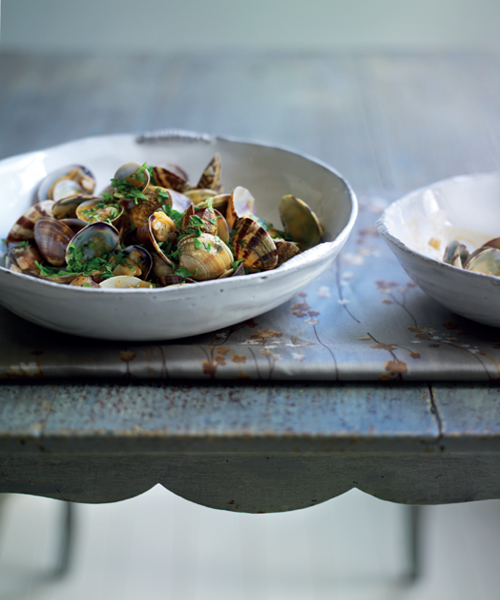
Crab bisque
A bisque is a gorgeous rich creamy soup made using fish, shellfish or meat. This crab bisque is fab — the sweetness of the crab meat is lightened ever so slightly by the tomatoes and ginger. You can either buy cooked crab meat or to cook your own (see below). Serve the soup as a starter or for lunch with crusty bread.
SERVES AT LEAST 6
50g (2oz) butter
1 onion (about 200g/7oz), peeled and chopped
Salt and ground black pepper
400g (14oz) cooked crab meat from 2 medium–large crabs (white and brown meat if possible)
100ml (3½fl oz) dry white wine
2 tsp peeled and finely chopped root ginger
600ml (1 pint) Crab or Prawn/Shrimp Stock (see opposite) or fish stock
200g (7oz) chopped fresh or tinned tomatoes
100ml (3½fl oz) single or regular cream
1 Melt the butter in a large saucepan on a medium heat, then add the onion with some salt and pepper and cook for 6–8 minutes or until the onion is softened but not browned.
2 Add all the remaining ingredients apart from the cream and simmer gently for 15–20 minutes or until the tomatoes are completely soft.
3 Remove the saucepan from the heat and whiz the soup in a blender. Reheat gently if necessary and stir in the cream, season to taste and serve immediately with some crusty bread.
COOKING A CRAB
1 First place the crab in the freezer for a couple of hours so that it is unconscious before boiling. To cook it, place in a large saucepan, cover with water, add 1 tablespoon of salt for every 1.2 litres (2 pints) of water and bring to the boil.
2 Simmer on a medium heat for 20 minutes per 450g (1lb) and then pour off about two-thirds of the water, cover with a lid and continue to cook for a further 6 minutes. To check to see if the crab is cooked, gently shake it quite close to your ear and you shouldn’t hear liquid splashing around. Remove the crab and allow to cool.
3 Once the crab has cooled, remove the large claws and crack these (using a heavy weight or nut crackers), then extract every bit of meat using the handle of a teaspoon. Retain the shell if making dressed crab or stock, otherwise discard all of the shell. Turn the body of the crab upside down and pull out the centre portion.
4 Discard the gills, known as ‘dead man’s fingers’, each about 4cm (1½ in) long. Scoop out all the lovely brown meat and add it to the white meat from the claws. The meat can be used immediately or frozen for future use.
NOTE: 450g (1lb) of cooked crab in the shell yields approximately 175–225g (6–8oz) crab meat.
Crab or prawn/shrimp stock
If you have any shells left over after preparing and eating shellfish such as crabs, prawns or shrimps, then use them to make this shellfish stock. It can be used for the Crab Bisque (opposite) as well as the Ballycotton Prawn Soup. Stock can easily be frozen in small portions to be used whenever you need.
MAKES ABOUT 1.2 LITRES (2 PINTS)
1 litre (1¾ pints) crab, prawn or shrimp shells
1 glass of dry white wine
1 large onion, peeled and roughly chopped
1 stick of celery, trimmed and roughly chopped
1 carrot, peeled and roughly chopped
2 tbsp tomato paste
A few sprigs of parsley
1 small bay leaf
6 whole black peppercorns
1 tsp salt
1 Place the shells in a saucepan, cover with 1 litre (1¾ pints) of water and bring to the boil.
2 Add the remaining ingredients, bring back up to the boil, then reduce the heat and simmer (but do not boil) for 30 minutes, skimming off any foam that appears on the surface. If you are making crab stock, it is necessary to simmer the shells in a pan covered with a lid for 20 minutes.
3 Pour through a fine sieve or through muslin and use immediately or either keep in the fridge for up to 48 hours or freeze for up to 1 month.
RACHEL’S TIP
If you are using large crab shells, first break them up slightly by placing them in a thick plastic bag and bashing them with a rolling pin or even a hammer.
Salade Niçoise
This is, of course, a classic, and when made with freshly seared tuna and delicious seasonal vegetables, lovely free-range eggs and really good olive oil, it is a perfect, fresh daytime dish.
SERVES 6
18 small new potatoes, unpeeled
Salt and ground black pepper
18 French beans
3 handfuls of rocket leaves
3 chunky tuna steaks, seared
6 eggs, hard-boiled (see tip below), peeled and cut into quarters
2 tbsp chopped parsley
2 tbsp sliced or torn basil
6 very ripe tomatoes, cut into wedges
24 black olives with the stones in, or pitted if you prefer (see tip below)
2 tbsp capers, drained and rinsed
9 spring onions, trimmed and cut into 1cm (½in) chunks
18 tinned anchovies, drained and rinsed
Handful of chopped mixed herbs
For the dressing
3 tbsp extra-virgin olive oil
1 tbsp red wine vinegar
1 tsp runny honey
2 cloves of garlic, peeled and crushed
1 Place the potatoes in a saucepan and cover with water. Add a good pinch of salt and bring to the boil, then cook for 20 minutes or until tender. Drain the potatoes and cut into 2cm (¾in) chunks and set aside.
2 Meanwhile, bring another saucepan of water to the boil, add a good pinch of salt and cook the French beans for 3–4 minutes or until just cooked but still a little ‘squeaky’ when bitten, then drain and set aside.
3 Next make the dressing by placing all the ingredients in a clean screw-top jam jar. Season with a little salt and pepper, then place the lid on the jar and shake vigorously. Set aside.
4 Place the rocket leaves in a serving dish, then arrange the cooked potatoes and beans randomly on top, along with the remaining ingredients. Season with salt and pepper, pour over the dressing and sprinkle with the herbs. Toss the salad so all the ingredients are evenly coated in the dressing and serve immediately.
RACHEL’S TIPS
Boiling the eggs for 8–9 minutes will leave the whites completely cooked but the yolks still ever so slightly soft, which is ideal for this dish.
Try to resist buying olives that come ready-pitted in jars as they have much less flavour. To pit them, just give them a bash with the flat side of a chopping-knife blade and remove the stones.
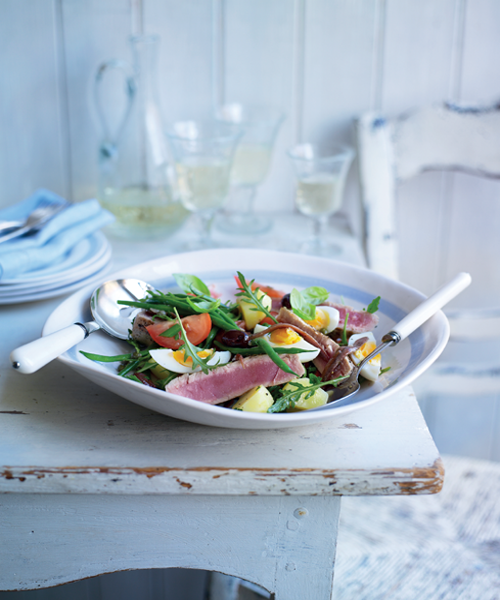
Chicken and cabbage salad
This is a wonderful, great big salad to serve as a centrepiece for a lunch with friends. Like any good salad, this one has a lovely balance of flavours and textures.
SERVES 6–8
4 large cooked chicken breasts or thighs, shredded
1 tsp chopped tarragon
3 tbsp extra-virgin olive oil
1 tbsp balsamic vinegar
200g (7oz) streaky bacon rashers
½ green leafy cabbage, such as Savoy
2 green eating apples, grated
3 large carrots, peeled and grated
2 tbsp mayonnaise
Salt and ground black pepper
1 In a large bowl, mix together the chicken with the tarragon, 2 tablespoons of olive oil and the vinegar.
2 Cut the bacon rashers into 2cm (¾in) pieces. Quarter the cabbage lenthways, remove the core and finely slice the leaves.
3 Place a frying pan on a medium-high heat and pour in the remaining olive oil. Add the bacon and cook, stirring frequently, for 3–4 minutes or until the bacon is golden and crispy. Remove from the pan and drain on kitchen paper.
4 When the bacon is cooked, add it to the bowl with the chicken, followed by all the remaining ingredients. Season to taste with salt and pepper, then toss together and serve.
Thai noodle broth
The Thai tradition of making a specially flavoured paste as a base for soups is a great way of dispersing flavours, but it’s also such a convenient method for entertaining, as the paste can be made beforehand and will keep for a week or two. I’ve used tiger prawns here, but you could use any prawns or chicken.
SERVES 3–4
75g (3oz) egg or rice noodles (optional)
1 × 400ml tin of coconut milk
450ml (16fl oz) chicken stock
250g (9fl oz) peeled raw tiger prawns
For the paste
1 bunch of coriander
1 lemongrass stalk (outer layer removed), roughly chopped
3 cloves of garlic, peeled
2 tbsp light soy sauce
1 tbsp fish sauce (nam pla)
2 tbsp caster sugar
½ red chilli, deseeded
To serve
½ red chilli, deseeded and sliced
Juice of 1 lime
A few splashes of fish sauce (nam pla)
1 Cook the egg or rice noodles (if using) following the instructions on the packet, then drain and rinse through with cold water. Drain again.
2 For the paste, remove the leaves from the coriander and chop 4 tablespoons of the leaves to serve. Set aside and put the stalks, together with the rest of the paste ingredients and 2 tablespoons of water, in a food processor. Whiz for 1–2 minutes or until smooth.
3 Pour into a large saucepan and cook for 1 minute on a medium heat, then add the coconut milk and stock and gently warm through for 5 minutes. Add the prawns and noodles (if using) and cook for a further 2 minutes.
4 To serve, stir in the chilli, chopped coriander leaves, lime juice and fish sauce, and pour into warmed bowls.
VARIATION
Thai chicken soup: Make the recipe as above, replacing the prawns with thin slices of raw chicken, adding the chicken 2 minutes before the noodles.
Pork rillettes
This has to be one of my very favourite things to eat! It’s a sort of rough pâté. Traditionally made just with pork, rillettes is now prepared with other types of meat and even fish, but the original is the best in my opinion. I usually pot it and serve it as a starter or for lunch with delicious breads from the market and some cornichons on the side. It will keep for a few months if left completely covered in the fat in a sealed jar.
MAKES 1 LITRE (1¾ PINTS)
500g (1lb 2oz) pork belly
500g (1lb 2oz) pork shoulder
200ml (7fl oz) dry white wine
6 cloves of garlic, peeled and roughly chopped
½ tsp freshly grated nutmeg
½ tsp ground black pepper, plus extra if needed
2 tsp sea salt, plus extra if needed
2 bay leaves
1 tbsp chopped thyme or rosemary leaves
Medium-sized casserole dish or ovenproof saucepan
1 Preheat the oven to 150°C (300°F), Gas mark 2.
2 Remove the rind and fat from the top of the pork and cut the flesh into 1–2cm (½–¾in) cubes. Also cut the pork shoulder into 1–2cm (½–¾in) cubes. Set the shoulder and flesh aside. Roughly chop the pork belly rind and fat into a few pieces and place in a roasting tin. Cook in the oven for ½–1 hour to render the fat, then pour the liquid into a bowl and discard (or eat!) the cooked rind. Set aside until later.
3 To make the rillettes, place all the remaining ingredients in a casserole dish or ovenproof saucepan with the meat. Place on a medium heat, stirring to mix everything together. Bring to simmering point, then cover with a lid and transfer to the oven. The rillettes need to cook for about 5 hours; all the fat on the meat should be rendered into liquid and the meat should be flaky and not at all chewy. You can break the meat up a little if you wish.
4 Taste for seasoning, then transfer to one or more sterilised preserving jars (see tip below), packing the meat down tightly and pouring over the rendered fat to just cover the meat. Allow to cool to room temperature so the fat has solidified before serving.
RACHEL’S TIP
To sterilise jars and bottles, put them through a dishwasher cycle, boil in a large saucepan filled with water for 5 minutes or place in a preheated oven (150°C/300°F/Gas mark 2) for 10 minutes.
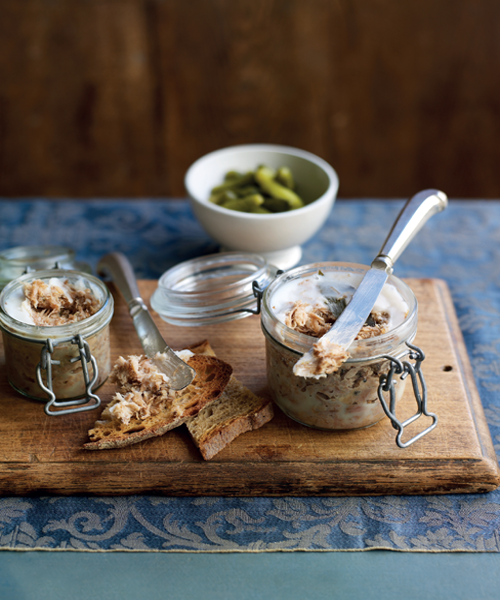
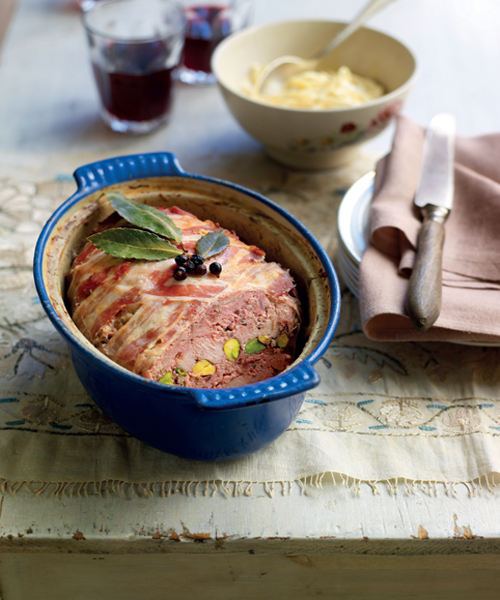
Game terrine with celeriac remoulade
I adore this kind of food for casual entertaining: thick slabs of a wonderful rustic winter terrine sitting on slices of crusty white or sourdough bread and some tangy celeriac remoulade on the side. This is great to serve for lunch when having friends staying over for the weekend. If you have a mincer, the texture will be better, however, you can mince meat in a food processor by pulsing a few times to get very small pieces.
SERVES AT LEAST 6
25g (1oz) butter, plus extra for greasing
1 large onion, peeled and very finely chopped
Salt and ground black pepper
300g (11oz) boneless mixed game bird meat, minced or pulsed in a food processor
200g (7oz) minced pork (at least 20% fat)
50g (2oz) streaky bacon, minced or pulsed in a food processor
Large pinch of freshly grated nutmeg
3 juniper berries, crushed
2 tsp chopped thyme leaves
8–10 rashers of streaky bacon, rind removed
25g (1oz) shelled pistachios
2 boneless game breasts (about 200g/7oz in total), such as pheasant, pigeon, partridge or woodcock, cut into strips
Bay leaves and juniper berries, to decorate





